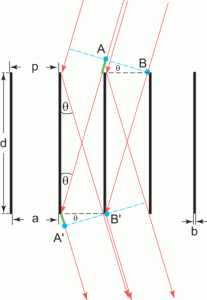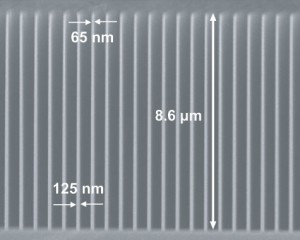Nanofabricated Reflection and Transmission Gratings
Diffraction gratings and other periodic patterns have long been important tools in research and manufacturing. Diffraction occurs due to the coherent superposition of waves and is a phenomenon with many useful properties and applications. Waves of many types can be diffracted, including visible and ultraviolet light, x-rays, electrons, and even atom beams. Periodic patterns have many useful applications in fields such as optics and spectroscopy; filtering of beams and media; metrology; high-power lasers; optical communications; semiconductor manufacturing; and nanotechnology research in nanophotonics, nanomagnetics, and nanobiology.
A long-standing problem with transmission gratings in the extreme ultraviolet (EUV) and soft x-ray bands has been the strong absorption of photons upon transmission and thus a low diffraction efficiency in this important wavelength band. We have recently solved this problem with the invention and fabrication of critical-angle transmission (CAT) gratings. This new design for the first time combines the high broadband efficiency of blazed grazing-incidence reflection gratings with the superior alignment and figure tolerances and the low weight of transmission gratings [1] [2]. The CAT gratings consist of ultrahigh-aspect-ratio, nm-thin freestanding grating bars with sub-nm smooth sidewalls that serve as efficient mirrors for photons incident at graze angles below the angle for total external reflection (see Figures 1 and 2). Blazing can concentrate diffracted power into a single or a few desired diffraction orders and has been confirmed through x-ray tests. Blazing also enables the use of higher diffraction orders and leads to manifold increases in spectral [3] and spatial resolution in spectrometer or focusing applications, respectively. We have achieved grating bar aspect ratios of ~ 150 in 6-micron-deep, 200-nm-period CAT gratings and are currently focusing on the minimization of internal support structures.
Work on high-resolution (R ~ 10,000 – 100,000) applications is also ongoing in the areas of high-precision patterning of silicon-immersion echelle gratings in infrared telescopes for astronomy [4] and blazed reflection gratings for high-resolution EUV and soft x-ray synchrotron applications [5].
- Figure 1: Schematic of the CAT grating principle. Diffraction peaks appear where the path length difference AA’-BB’ equals an integer multiple of the wavelength.
- Figure 2: Scanning electron micrograph of a cleaved cross-section through a 574-nm-period silicon CAT grating that was (intentionally) not etched all the way through. The grating bar aspect ratio is close to 100 and is increased to ~ 150 for the final grating.
References
- R.K. Heilmann, M. Ahn, E.M. Gullikson, and M.L. Schattenburg, “Blazed High-Efficiency X-Ray Diffraction via Transmission through Arrays of Nanometer-Scale Mirrors,” Optics Express, vol. 16, pp. 8658-8669, June 2008. [↩]
- M. Ahn, R. K. Heilmann, and M. L. Schattenburg, “Fabrication of 200 nm period blazed transmission gratings on silicon-on-insulator wafers,” Journal of Vacuum Science and Technology B, vol. 26, pp. 2179-2182, Dec. 2008. [↩]
- R.K. Heilmann, et al., “Development of a critical-angle transmission grating spectrometer for the International X-Ray Observatory” in Proceedings SPIE 7437, 2009, 74370G. [↩]
- J.P. Marsh et al., “Fabrication and performance of silicon immersion gratings for infrared spectroscopy,” in Proceedings SPIE 6269, 2006, 62694J. [↩]
- D.L. Voronov et al., “5000 Groove/mm multilayer-coated blazed grating with 33% efficiency in 3rd order in the EUV wavelength range,” in Proceedings SPIE 7448, 2009, 74480J. [↩]

